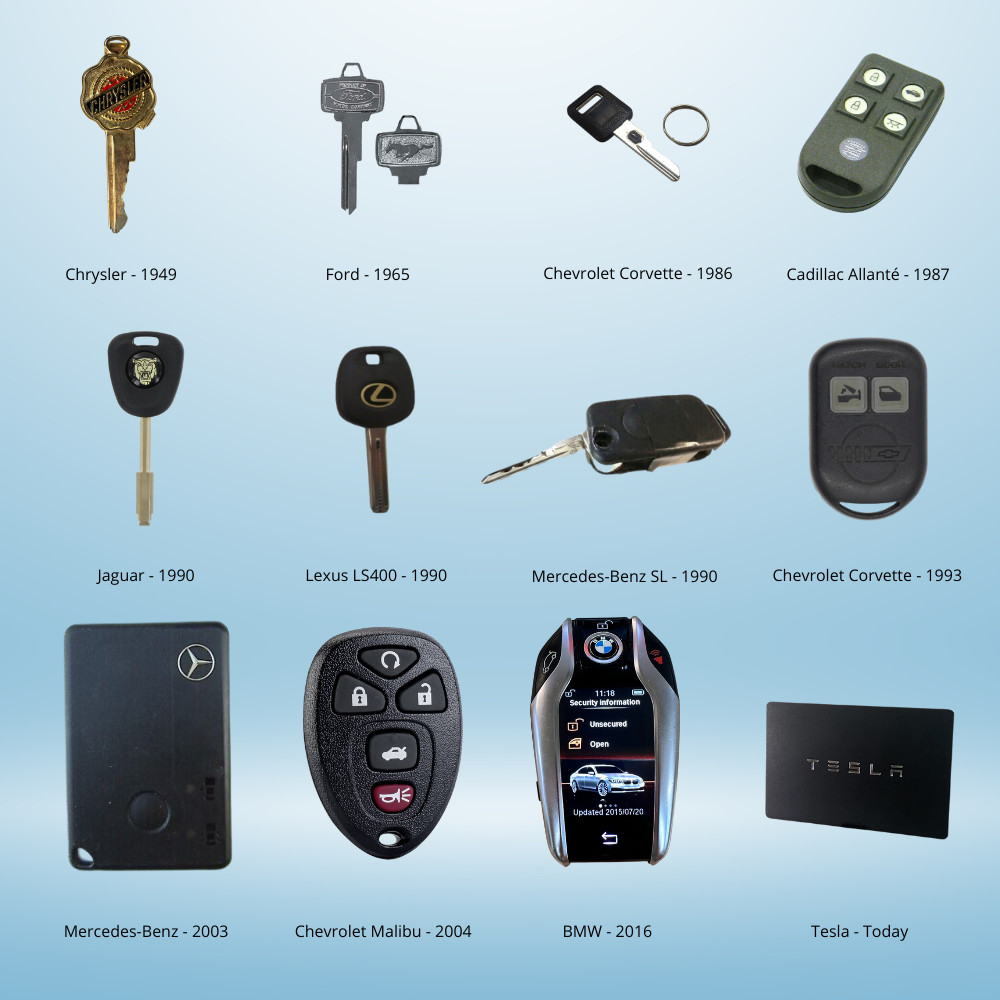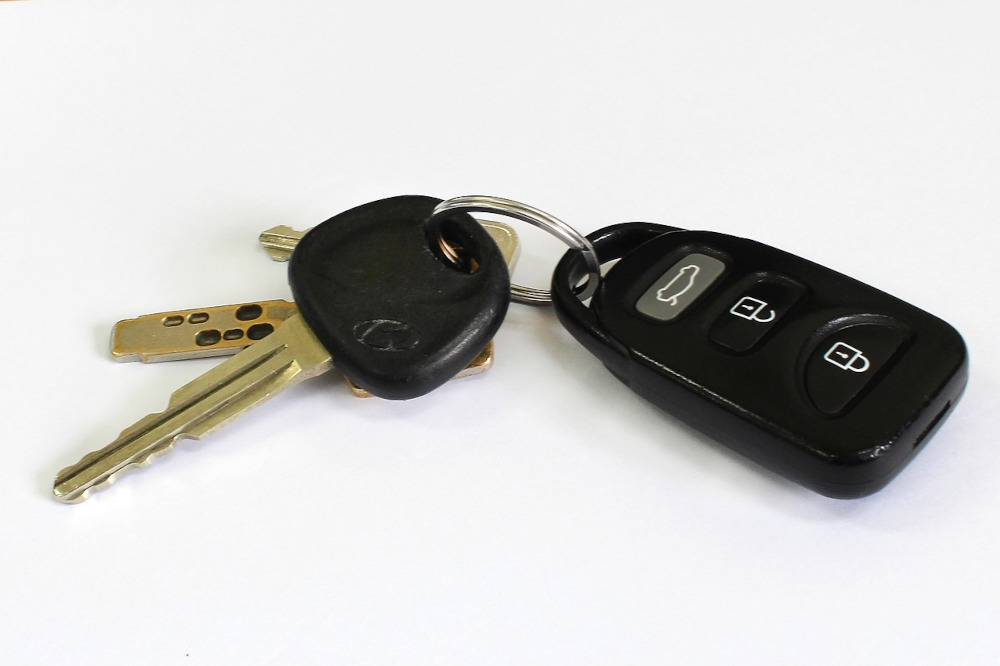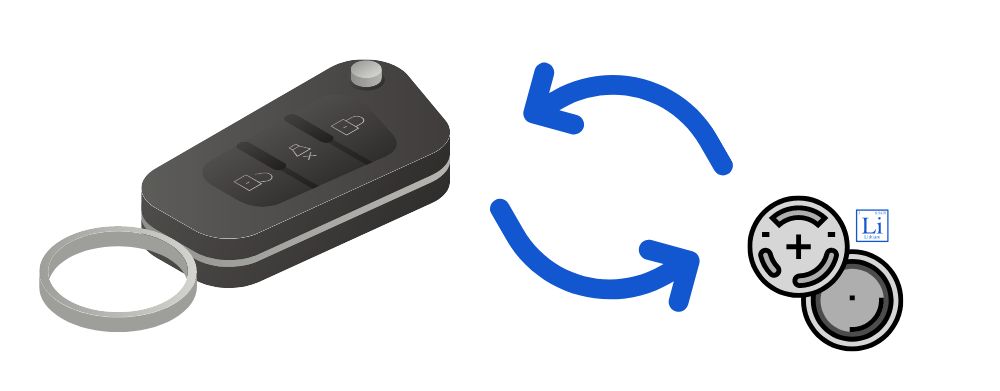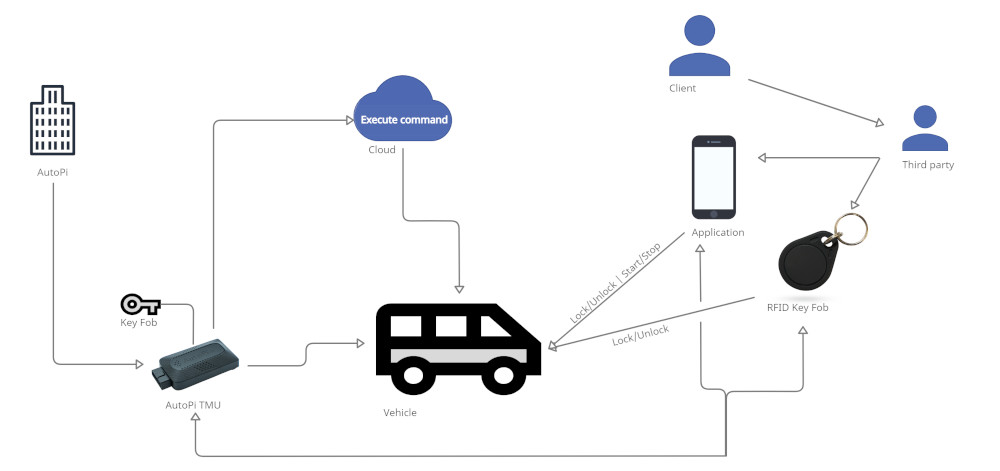Key fobs have transformed how we interact with our vehicles, offering convenience and security at the touch of a button. These handy devices allow you to unlock your car, start the engine, and even open the trunk remotely.
At AutoPi, we’ve helped countless clients understand and program their key fobs, improving their fleet management operations.
Drawing from our expertise and hands-on experience, we believe this guide will provide you with accurate and reliable information. Whether you’re new to key fobs or looking to deepen your understanding, this article is designed with you in mind.
Let's take a closer look at what a key fob is, how it works, and the benefits it brings to modern driving and fleet operations.
What is a Key Fob?
A key fob is a small, handy device that lets you control various functions of your car remotely. With just a click, you can lock or unlock your doors, start the engine, and sometimes even pop open the trunk. These devices have become a standard feature in modern cars, making our lives easier and our vehicles more secure.

Car key fobs have come a long way since their humble beginnings.
Back in the 1980s, the first key fobs were simple remote controls that used infrared signals to lock and unlock car doors. Fast forward to today, and these little gadgets have evolved dramatically. Modern key fobs use radio frequency identification (RFID) and other wireless technologies, offering a range of new features.
Today’s key fobs are pretty smart.
They’re often integrated with advanced systems that allow for keyless entry and ignition. Some can even start your car remotely, which is perfect for preheating or cooling your car before you get in.
We’ve seen it firsthand how these advancements have made driving more convenient for our clients.
What Does Key Fob Stand For?
You might be wondering, “What does ‘key fob’ actually mean?
The term “fob” has been around for a while and originally referred to a small pocket or a chain attached to a pocket watch. In the world of cars, a key fob is simply a small electronic device that fits in your pocket or attaches to your keychain. The "key" part is pretty self-explanatory, linking it to its primary role related to car keys.
Types of Car Key Fobs
There are several types of car key fobs, each offering different levels of functionality:
-
Standard Key Fobs: These are the most basic and typically allow you to lock and unlock doors and possibly open the trunk.
-
Smart Key Fobs: These offer advanced features like keyless entry and ignition, meaning you can start your car without physically inserting a key.
-
Proximity Key Fobs: These are super convenient as they detect your presence and allow you to unlock and start your car just by being nearby, without pressing any buttons.
How Key Fobs Works
Car fobs might seem like magic, but they rely on some truly fascinating technology to function.
Let's dive into the inner workings of these small yet powerful devices and see how they manage to control your car with just the push of a button.
Internal Components
Inside every key fob, there’s a compact yet powerful assembly of components working together. The main parts include:
-
Microchip: This tiny computer chip stores a unique code that is matched with your car.
-
Battery: A small but long-lasting battery powers the key fob, ensuring it’s always ready when you need it.
-
Transmitter: This component sends the microchip's code to your car.

Communication Technology
As mentioned, key fobs communicate with your car using RFID or other advanced wireless technologies like Bluetooth, BLE or Near Field Communication (NFC).
Here’s a simple step-by-step breakdown of how they work:
-
Button Press: When you press a button on the key fob, it activates the microchip inside.
-
Signal Generation: The microchip generates a unique code that matches your car’s receiver. This code is like a secret handshake that only your car recognizes.
-
Signal Transmission: The transmitter sends this code as a radio signal through the air to your car.
-
Receiving Signal: Your car’s receiver, which is always on the lookout for the correct code, picks up the radio signal.
-
Code Verification: The car’s system verifies the received code against the one stored in its memory. If the codes match, it’s like your car saying, "Welcome back!"
-
Action Execution: Once the codes are verified, the car performs the requested action, such as unlocking the doors, starting the engine, or even popping the trunk.
This entire process happens almost instantaneously, giving you full control over your car with just the push of a button.
It’s amazing to think about how this small device, which fits in the palm of your hand, houses such complex technology.
Uses of Key Fobs
Car key fobs have revolutionized the way we interact with our vehicles. They offer a range of features designed to make driving more convenient, secure, and enjoyable.
Let’s explore the various uses of key fobs and how they enhance the driving experience.
Keyless Entry
As we already covered, one of the primary functions or features of a car key fob is keyless entry.
Gone are the days of fumbling with traditional keys. With a simple press of a button, you can lock and unlock your car doors from a distance. This feature is incredibly handy, especially when you’re carrying bags or dealing with inclement weather.
Keyless Ignition
Many modern vehicles come equipped with keyless ignition, also known as push-button start.
With this feature, you can start your car without inserting a key into the ignition. As long as the key fob is inside the vehicle, you can start the engine with just a press of the start button. This not only adds convenience but also enhances security, as the car won’t start without the presence of the correct key fob.
Remote Start
Remote start is a feature that allows you to start your car from a distance using the key fob.
This is particularly useful in extreme weather conditions. Imagine warming up your car on a cold winter morning or cooling it down on a hot summer day before you even step outside. This feature ensures that your car is at the perfect temperature by the time you’re ready to drive.
Trunk Release
Many key fobs include a trunk release button, allowing you to open the trunk remotely. This is especially helpful when your hands are full, making it easier to load and unload items from your vehicle.
Panic Button
For added safety, most key fobs come with a panic button. When pressed, it activates the car’s alarm system, which can deter potential thieves and attract attention in an emergency. This feature provides an extra layer of security and peace of mind.
Customizable Settings
Some advanced key fobs allow you to customize settings for different drivers.
For example, you can program the key fob (find out how you can program your key fob) to adjust the seat position, mirror angles, and climate control preferences based on the driver’s preferences. This personalized approach enhances comfort and convenience.
Our talented developer team has helped many clients maximize the benefits of their key fobs, ensuring they get the most out of these features. Whether it’s setting up remote start or troubleshooting keyless ignition issues, our expertise ensures the clients enjoy all the conveniences that key fobs offer.

Maintaining Your Key Fob
Car key fobs are designed to be durable and long-lasting, often functioning perfectly for many years with minimal maintenance. However, occasional upkeep can help ensure they remain reliable and efficient.
Here’s how you can keep your key fob in top shape.
Checking and Replacing the Battery
While key fobs are built to last, their batteries will eventually need replacement.
In many cases, a key fob battery can last several years — some people go as long as seven years without needing a change.

Here’s a simple step-by-step guide to checking and replacing your key fob battery:
-
Check Battery Status: If your key fob isn’t working as well as it used to, such as requiring closer proximity to the car, it might be time to check the battery.
-
Open the Key Fob: Using a small screwdriver or a coin, carefully pry open the key fob. Be gentle to avoid damaging the casing.
-
Remove the Old Battery: Take out the old battery and note its orientation (which side is up).
-
Insert the New Battery: Place the new battery in the same orientation as the old one. Make sure it’s securely in place.
-
Close the Key Fob: Snap the two halves of the key fob back together, ensuring they are properly aligned.
Regularly replacing the battery, even if it lasts a long time, can prevent the key fob from failing when you need it most.
When to Replace a Car Key Fob
Although key fobs are built to last, sometimes the fob itself may need replacing due to physical damage, water exposure, or internal component failure.
Here are some signs that it might be time for a new key fob:
-
Unresponsive Buttons: If the buttons don’t work even after replacing the battery, the fob might be damaged.
-
Physical Damage: Cracks or other visible damage can affect the fob’s functionality.
-
Intermittent Functioning: If the fob works sporadically, it could indicate a deeper issue.
Replacing a key fob can be more complex than simply replacing the battery. It often requires reprogramming to match your car’s security system.
Costs and Considerations
The cost of replacing a key fob can vary depending on the make and model of your car. Basic key fobs are generally less expensive, while smart and proximity key fobs can be more costly due to their advanced features.
Here are some considerations:
-
OEM vs. Aftermarket: Original Equipment Manufacturer (OEM) key fobs are made by your car’s manufacturer and tend to be more expensive. Aftermarket key fobs are cheaper but may not offer the same quality or features.
-
Programming Fees: Replacing a key fob usually involves programming it to work with your car, which can incur additional costs.
-
Professional Help: While some key fob replacements can be done at home, others may require professional assistance, especially for newer, more advanced models.
Maintaining your key fob ensures it remains reliable, providing the convenience and security you expect. Regular checks and timely replacements, even if infrequent, can save you from unexpected hassles.
Troubleshooting Common Issues
Even though key fobs are designed to be durable and reliable, occasional issues can arise. Here are some common problems and how to fix them:
Signal Interference
If your key fob isn’t working from its usual distance, signal interference might be the cause. Try these steps:
-
Remove Interferences: Keep the fob away from electronic devices and metal objects.
-
Reposition the Fob: Change the position or angle of the key fob.
-
Check the Car's Antenna: Ensure the car’s antenna is clean and unobstructed.
Physical Damage
Physical damage can affect the key fob's functionality. If it has been dropped or exposed to water:
-
Inspect for Damage: Look for cracks or signs of water damage.
-
Dry Out Moisture: If wet, remove the battery and let it dry completely before reassembling.
-
Consider Replacement: Replace the fob if damage is severe.
Security Concerns
With advancements in technology, there’s a risk of signal hijacking. To protect against this:
-
Use a Signal Blocking Pouch: Store your key fob in a Faraday pouch.
-
Disable Keyless Entry: Turn off this feature if not needed.
-
Stay Informed: Keep up-to-date with security recommendations for your vehicle.
Preventive Measures
-
Regular Maintenance: Check your key fob periodically and replace the battery as needed.
-
Safe Storage: Keep your key fob in a safe, dry place.
-
Professional Checkups: Seek professional help for persistent issues.
The Future of Car Key Fobs
Car key fobs have already revolutionized how we interact with our vehicles, but the future holds even more exciting developments. Let's explore what the next generation of key fobs might look like.
Biometric Key Fobs
-
Imagine a key fob that recognizes your fingerprint or even your face. Biometric key fobs could enhance security by ensuring that only the owner can unlock and start the vehicle. This technology is already being explored and could soon become a standard feature in high-end cars.
Smartphone Integration
-
The future might see your smartphone completely replacing your key fob. With apps that allow you to unlock, start, and locate your car, the convenience of having everything on one device is undeniable. Some car manufacturers are already rolling out these features, allowing drivers to control their cars from their phones.
Enhanced Connectivity
-
Future key fobs might offer even more connectivity, integrating with smart home systems and other IoT devices. Imagine your car communicating with your home’s security system or your smart thermostat adjusting based on your commute time.
Market Trends and Innovations
The automotive industry is continuously innovating, and key fobs are no exception. Here are some trends to watch:
-
Increased Security Features: As car theft techniques evolve, so will the security measures in key fobs. Expect more advanced encryption and anti-hacking technologies.
-
Sustainability: With a push towards greener technologies, future key fobs might be more environmentally friendly, using sustainable materials and energy-efficient components.
-
Customization: Future key fobs could offer more personalization options, allowing users to customize settings, preferences, and even appearance.
Predictions for the Future
The future of car key fobs looks promising, with continuous advancements aimed at making our driving experience safer, more convenient, and more integrated with our digital lives. As technology progresses, we can expect key fobs to become smarter, more secure, and even more essential in our daily routines.
Going Keyless with Your Key Fob and AutoPi
Managing a fleet has never been easier with AutoPi's keyless entry system. Enhance your fleet operations with seamless technology designed for efficiency and security. AutoPi’s keyless entry system streamlines your fleet operations by allowing drivers to unlock and start vehicles without physical keys, reducing hassle and improving turnaround times.
With AutoPi, you can remotely start, lock, and unlock vehicles, perfect for managing large fleets and controlling multiple vehicles from a central location. Build it yourself using our Keyfob kit.
AutoPi provides advanced encryption and secure communication, ensuring that only authorized personnel can access and operate your vehicles, reducing the risk of theft and unauthorized use. The system integrates seamlessly with your existing fleet management systems, allowing you to monitor vehicle status, track locations, and manage access from your smartphone or computer.
AutoPi offers easy installation and comprehensive support to get your fleet up and running quickly.
Key Features:
-
Simplify fleet management with keyless entry
-
Remote access for starting, locking, and unlocking vehicles
-
Enhanced security with advanced encryption
-
Integration with existing fleet management systems
-
Easy installation and support
Discover how AutoPi can transform your fleet management by visiting our Keyless Entry feature page. Upgrade your fleet management with AutoPi’s keyless entry system for unmatched convenience and security.

Conclusion
Car key fobs have significantly changed how we interact with our vehicles, providing unmatched convenience and security.
From their basic function of keyless entry to advanced features like remote start and smartphone integration, these small devices play a big role in our daily driving experience.
Understanding how key fobs work, how to maintain them, and how to troubleshoot common issues ensures you can rely on your key fob whenever you need it. With the potential for future advancements like biometric security and enhanced connectivity, the key fob’s role in automotive technology is only set to grow.
We pride ourselves on staying ahead of these trends, helping our clients get the most out of their key fobs. Whether you need assistance with programming, maintenance, or upgrading to the latest technology, we’re here to help.
Thank you for joining us on this journey through the fascinating world of car key fobs. We hope this guide has provided you with valuable insights and practical advice.
Stay tuned for more updates and innovations in the automotive world!




